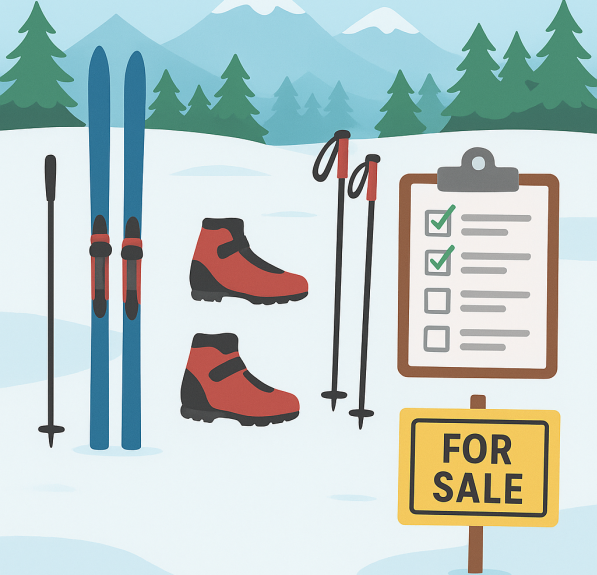How to Sell Your Cross-Country Ski Gear at a Ski Swap

Share
Got extra skis gathering dust in the garage? A local ski swap is one of the best ways to give your old gear a second life — and help someone new get into the sport. Whether you’re upgrading, clearing space, or passing on gear that’s still got lots of glide left, here’s how to make sure your equipment sells quickly and fairly.
🧽 1. Clean It Up
First impressions matter. A quick cleanup can turn a maybe into a yes.
- Skis: Wipe topsheets with a damp cloth. Scrape and brush off any glide wax. ‼️ Remove any old grip wax — nothing is worse than sticky skis at a swap. Slide on a pair of ski ties to keep the pair together.
- Poles: Clean off dirt and grime; check straps and baskets.
- Boots: Give them a quick scrub.
A clean ski looks better — and signals that it’s been cared for.
🧰 2. Check Condition Honestly
Buyers appreciate transparency. Give your gear a quick inspection before bringing it in:
- Bases: Minor scratches are fine, but deep gouges or dry (white) bases should be noted. Use masking tape to mark damage and draw arrows to show the spot. Do the same for gouges on the topsheet or side walls. Check for delamination of the base, particularly near the tips and tails, and where the base meets the sidewalls.
- Camber: Press skis base-to-base; if they no longer spring apart, label them as “training” or “rock skis.”
- Bindings: Check that they’re intact and identify whether they’re NNN or SNS.
- Poles: Make sure baskets and tips aren’t loose.
- Boots: Test zippers and lacing; check soles for cracks.
If it’s truly worn out, consider donating it for parts or recycling — not selling.
💸 3. Price It Fairly
A realistic price is the difference between a sale and something that sits all day. Here’s a general guide (may vary by region):
- Like-new gear (1–2 seasons old): ~60–70% of retail
- Good condition (3–5 seasons): ~40–50% of retail
- Older but functional: $20–$80, depending on type and condition
Check local listings or ask ski swap volunteers for help setting a fair price.
🏷️ 4. Label Everything Clearly
Use tags or tape to note:
- Ski and type (e.g., “Classic 197cm” or “Skate 182cm”)
- Recommended weight range (if known) and suitable conditions
- Pole length or boot size
- Your name and contact info (if required)
🧾 5. Know the Swap’s Rules
Each ski swap runs a little differently. Check the event details for:
- Registration forms (some need to be filled out beforehand)
- Drop-off and pick-up times
- Commission or club fee (usually 10–20%)
- Payment method (cheque, e-transfer, etc.)
Following the system helps volunteers and ensures you get paid properly.
🧴 6. Add Value with a Small Tune-Up
If you really want your skis to stand out, give them a fresh glide wax before the swap. A simple hot wax and scrape can make used skis look — and slide — like new. It’s a small effort that can make a big difference in perceived value.
🏔️ 7. Be Part of the Community
Ski swaps aren’t just about buying and selling — they’re about helping more people get on snow. By selling good used gear, you’re helping keep the sport affordable and sustainable. And who knows — your old skis might be the ones that get a kid hooked for life.
If your gear doesn’t sell, consider donating it to a ski club for their library or rental fleet.
✅ Printable Checklist: What to Do Before Selling at a Ski Swap
🏁 Final Tip
When in doubt, ask a local coach or wax tech for advice — they often know what sells best. Once you’ve cleared out your old gear, treat yourself to a fresh start with new glide waxes, kick waxes, and tools for the season at Skiwax.ca.
